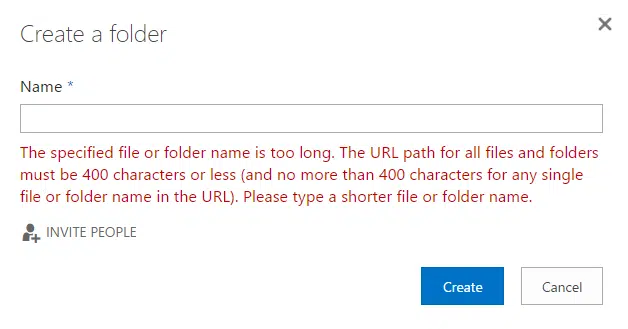Last Updated on December 14, 2023
Wondering if there’s a right way to name items in SharePoint?
In this guide, you will learn about the naming conventions in SharePoint, why they matter, the common pitfalls to avoid, and many more.
Let’s get started.
Table of Contents:
Why Naming Conventions Matter
Naming conventions are more than just a superficial layer:
They are the backbone of efficient navigation, searchability, and administration.
Here are reasons why it’s important to get the naming conventions right:
Using clear and consistent naming conventions paves a smooth road for everyone who accesses your SharePoint site.
This is crucial not just for document name clarity but also for overall user experience.
Think of the names as signposts:
The clearer and more descriptive they are, the easier it is for users to find what they’re looking for.

This reduces frustration and boosts productivity, making for a far better user experience.
2. Improved Searchability
SharePoint has robust search features — but these tools can only be as effective as your naming conventions allow them to be.
Precise and descriptive names make your files easily discoverable.
When you search for specific filenames, you get specific results:

This not only saves time but also ensures that the right files are accessed for the right tasks, thus avoiding costly mistakes.
Related: How Does SharePoint Search Work: The Beginner’s Search Guide
3. Compliance and Security
In many industries, proper data management is not just good practice — it’s the law.
Regulatory bodies may require your organization to maintain certain data management standards, which often include file naming.
Proper naming conventions can help ensure that you meet these compliance requirements.
Additionally, good naming can help in setting up security protocols, making sure that sensitive files are easily identifiable for restricted access.
Related: How to Protect Confidential Content on SharePoint Online
4. Avoid Technical Problems
Technical limitations also dictate the need for effective naming conventions.
For example, SharePoint Online has a 400-character limit for the entire file path:

This includes the following:
- Tenant name
- Site name
- Folder name
- File name
By keeping your naming conventions concise:
You avoid running into these technical roadblocks that might require you to shorten file names or shorten folder names.
Related: SharePoint Online Limits: The Complete Guide (Updated)
Sign up for exclusive updates, tips, and strategies
It’s easy to overlook the importance of a consistent and logical naming system.
However, this can lead to a host of problems that can disrupt workflow, create confusion, and even pose security risks.
Here are the most common pitfalls you might encounter in SharePoint naming:
1. Using Special Characters
Incorporating special characters like “!”, “#”, or “&” in your file or folder names might seem harmless.
This is because a lot of people use them on Windows file system names and even on regular files on Windows.
But in SharePoint, unfortunately:
- These characters can disrupt link functionalities.
- They can also complicate the search process for files.
- Moreover, they may even trigger errors within the SharePoint system.
It’s best to stick with alphanumeric characters to keep things running smoothly.
2. Overly Complex Names
You might think that adding lots of details in file names is beneficial.
But it can actually have the opposite effect:
- Names that are too intricate can create confusion among team members.
- They are also harder to remember and cumbersome to type out.
- Complicated names hinder the search process and negatively affect user experience.
The goal should be to create names that are short, descriptive, and straightforward for ease of use and efficient searchability.
3. Inconsistency
Inconsistent naming practices are one of the biggest culprits for inefficiency.
When different departments or individuals use their own naming styles, it creates a chaotic environment.
The result? Files are harder to locate and manage.
A standard naming convention is essential for maintaining order and maximizing productivity.
4. Ignoring Folder Structure
Folder structure is often overlooked when people focus solely on file naming.
However, the way folders are named and organized also plays a vital role in how easily information can be accessed.
Poor folder naming can lead to a confusing hierarchy that impedes navigation.
In terms of hierarchy, creating a flat information architecture is the key (with folders and metadata).
Related: SharePoint Folders vs Metadata (Comparison and Differences)
The question now is — what goes into creating a good naming convention for SharePoint?
Here are the key elements you need to consider.
1. Clarity
The primary goal of any naming convention is to make files and folders easily identifiable.
For this:
- Names should be self-explanatory so that any team member
- Regardless of their familiarity with the project
- Can understand what a file or folder contains just by looking at its name
The more intuitive the naming, the less time you will spend searching for files.
2. Brevity
While clarity is crucial, brevity is equally important.
Long names can be:
- Cumbersome to read
- Hard to remember
- May even run into character limits imposed by SharePoint
Aim for a naming convention that is both concise and descriptive.
It’s a balancing act but achieving it will make life much easier for everyone involved.
3. Relevancy
The essence of the name should directly correlate with the content or purpose of the file or folder.
Here’s what to remember:
- This involves steering clear of ambiguous or unclear names.
- Always opt for names that give a transparent glimpse into the file’s content.
For instance:
A name like “Sales-Report-Q4-2023” is much more illuminating and pertinent than a vague “File123.”
4. Consistency
Uniformity is vital for maintaining order in your SharePoint ecosystem:
- Choose a single naming format that suits your needs.
- Consistently apply this style to all files and folders, irrespective of the project or department.
Whether you choose PascalCase, kebab-case, or any other stylistic approach:
Consistency is the linchpin for a well-organized SharePoint site.
5. Date Formatting
Adhering to a uniform date format is key for effective file sorting.
- A standardized date layout helps in a chronological organization.
- Avoid employing multiple date formats that can generate confusion.
For instance:
Stick to a “YYYY-MM-DD” format rather than juggling between “DD/MM/YY” or “MM-DD-YYYY.”
6. Version Control
When dealing with multiple file versions, including versioning information in your naming is crucial.
- This enables effortless identification of the most recent file version.
- It also facilitates tracing previous versions when needed.
By incorporating version numbers, you simplify the process of managing multiple iterations of a document.
Using these elements, you’re setting the stage for an organized, efficient, and user-friendly environment.
What you need to do demands careful planning, team input, and a nuanced understanding of your organization’s requirements.
Here’s an actionable guide on how to craft a naming convention:
1. Conduct a Thorough Assessment
Before you dive into creating rules for naming:
Take some time to assess the unique needs and structure of your organization
Action steps:
- List the types of files commonly used across departments in your document library
- Identify the key users and their roles
- Evaluate existing naming practices, including handling separate major version number
This thorough assessment ensures that your naming conventions will align with your specific organizational needs.
2. Draft Initial Guidelines
Based on your assessment, start drafting a set of guidelines for naming files and folders.
Action steps:
- Use the assessment to draft preliminary naming guidelines
- Make sure to address important elements like clarity, brevity, and relevancy
This draft will act as the blueprint for your ultimate naming convention.
3. Seek Team Feedback
Once you have a draft, share it with a diverse group of team members for feedback.
Action steps:
- Share the draft guidelines with team members across different departments
- Collect their feedback via meetings or digital surveys
- Revise the draft based on the received input
Your naming convention should be a collaborative effort to ensure its practicality and ease of use.
4. Finalize and Document
After incorporating feedback, finalize your naming convention guidelines.
Action steps:
- After considering all feedback, finalize your naming convention
- Document the rules, including illustrative examples
- Make this document easily accessible, perhaps by uploading it to a central SharePoint location
Documentation ensures that everyone can easily refer to the naming rules as needed.
5. Train the Team
A naming convention is only as good as its implementation.
Educate your team members on the importance of the naming convention and how to use it.
Action steps:
- Host training sessions to go over the new naming rules
- Create quick-reference guides or cheat sheets
- Distribute these materials during the training
Training ensures that your naming convention doesn’t just look good on paper but is effectively implemented.
6. Monitor and Audit
Implement a regular schedule for monitoring and auditing files and folder names.
This is to ensure adherence to the naming convention.
Action steps:
- Schedule regular checks to ensure compliance with the naming convention
- Use SharePoint auditing tools to make this process easier
- Address any deviations promptly
Regular monitoring helps maintain the integrity and efficiency of your SharePoint site.
7. Periodic Reviews
The needs of your organization may evolve over time:
Your naming convention should be flexible enough to accommodate these changes.
Action steps:
- Periodically revisit the naming guidelines.
- Update them to accommodate any organizational changes or feedback.
- Re-train the team if significant changes are made.
Regular reviews ensure that your naming convention adapts to the evolving needs of your organization.
There’s a lot I explained earlier.
However, having a set of best practices for naming conventions can simplify your journey significantly.
Here are sets of best practices you can adopt:
1. Do’s
What you should include in your naming convention:
- Use descriptive names: Always aim for names that give a clear idea of the content
- Be consistent: Stick to a standardized naming style across all departments and projects
- Include dates: If relevant, include dates in a standardized format, such as “YYYY-MM-DD,” for easy chronological sorting
- Use version numbers: For files that undergo multiple revisions, include document versions to track changes effectively
2. Don’ts
What to avoid in your naming convention:
- Avoid special characters: Characters like “/”, “#”, or “&” can be considered invalid characters and can cause technical issues in web URLs
- Don’t use spaces: Spaces can cause problems, especially in URLs. Opt for hyphens or underscores instead
- Steer clear of ambiguity: Names like “Final” or “New” can become misleading over time
- Don’t exceed character limits: Be mindful of SharePoint’s character limits for file paths, which is 400 characters in SharePoint Online
3. Folder vs File Naming
Differentiating strategies for folders and files:
- Folders: Use broader categories for folder names to allow for easy nesting of files
- Files: Use more specific descriptors in file names to make them easily searchable
4. Accessibility
Making names accessible for everyone:
- Use plain language: Avoid jargon or acronyms that might not be understood by everyone
- Case sensitivity: Be mindful that SharePoint is case-insensitive, so consistency in case usage is crucial for avoiding duplication
5. Periodic Review
Ongoing monitoring and updates:
- Conduct regular audits to ensure compliance with the naming convention
- Update the naming guidelines as necessary, especially if there are changes in team structures, project scopes, or organizational goals
Using Naming Conventions
Naming conventions in SharePoint are not just a matter of aesthetics or personal preference:
They serve as the foundation for efficient navigation, improved searchability, compliance, and avoiding technical issues.
If you need further clarification on SharePoint naming conventions, don’t hesitate to drop a comment below.
For any business-related inquiries or if you need specialized guidance, feel free to reach out using the contact form on this page.


I’m used to opening excel files through VBA on a share drive using wildcard for partial file names like: Workbooks.Open FileName:=”https://sap.sharepoint.com/sites/YadaYada/2024_Version” & “*” & “.xlsb”
where * here is something like “57×03”.
What line(s) of code must I do now to open 1 or more files with this partial file name?
Ideally would just open just the most recently saved file meeting the criteria.
Any help would be appreciated, thanks!
Great post … I’m finding it difficult to achieve change in file naming amongst my colleagues 😕